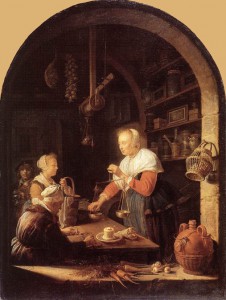By Miranda Safir
The history of the orange carrot is surprisingly controversial. One expert, Koert van Mensvoort, argues that in the 1500s Dutch farmers from Hoorn in the northern Netherlands utilized selective breeding to grow orange carrots (RNW). Prior to this time carrots came in an expansive list of hues ranging from purple, yellow, and red. The wild carrot, which grew all over Europe and the Middle East, was first domesticated in Afghanistan thousands of years before the development of the orange carrot (Stolarczyk and Janick 13). Some people believe the orange carrot was developed by the Dutch as a symbol of patriotism, due to the newly established House of Orange by William of Orange. However, there is no evidence to back this theory up although it is widely believed to be true (RNW).
The World Carrot Museum describes a much more complex and contradictory origin story of the orange carrot, which points to the first record of their existence, which can be found in Byzantine manuscripts from 512 AD (Stolarczyk). It is clear, however, that the Dutch certainly mastered the domestication of the orange carrot. In a document by the U.S. Department of Agriculture from 1940 on varieties of carrots, the Dutch are credited with developing the orange carrot and selling the seeds to the British who then brought them to early America. The publication states that by 1610 carrots and seeds were being sold in markets all over Amsterdam (United States 14). In the New Netherlands carrots became a staple in the garden and recipes (Barnes and Rose 58). Other publications credit English pilgrims entirely for the popularity of the orange carrot in the New World and for the quick adoption of the crop by Native Americans.
However, one should not forget where the orange carrot was born: the Netherlands. The Dutch should really get the credit for its creation (Stolarczyk and Janickn 17). Back in the Netherlands orange carrots became so common that they were incorporated into the Golden Age paintings of daily life for which the Dutch are so renowned. This can be seen in Gerrit Dou’s painting The Grocer’s Shop in which orange carrots are prominently featured on the window ledge that allows us to look into the shop (Figure 1). Dou is a famous Dutch painter who started to work for Rembrandt at the tender age of fifteen. He himself became well known for his detailed genre paintings. Dou is credited with founding the Leiden School of fijnschilders, which means “fine painters” in Dutch (NGA). His painting incorporating orange carrots was painted in 1647. It is oil painted on wood panel (Dou). Dou’s work can be seen around the world today and his paintings sell for extremely high prices. Although his paintings captivate internationally, Dou never left the Netherlands (Rijksmuseum). It is amazing that the carrots we eat today are the same as those depicted in paintings by numerous Dutch masters. Even more spectacular is the fact that there is so much controversy around the origin of the orange carrot, which few Americans have realized.

Figure 1 Gerrit Dou.The Grocer’s Shop. 1647. Oil on wood panel. Musée du Louvre, Paris.
Works Cited
Barnes, Donna R., and Peter G. Rose. Matters of Taste: Food and Drink in Seventeenth-century Dutch Art and Life. Albany, NY: Syracuse UP, 2002. Print.
Dou, Gerrit. The Grocer’s Shop. 1647. Musée Du Louvre, Paris. Carrotmuseum.co.uk. Carrot Museum. Web. 10 Apr. 2016. <http://www.carrotmuseum.co.uk/art1.html>.
National Gallery of Art. “Gerrit Dou: Master Painter in the Age of Rembrandt.” Nga.gov. National Gallery of Art Washington D.C., 2016. Web. 10 Apr. 2016. <http://www.nga.gov/exhibitions/2000/dou/splash.htm>.
Rijksmuseum. “Gerard Dou.” Rijksmuseum.nl. Rijksmuseum, n.d. Web. 10 Apr. 2016. <https://www.rijksmuseum.nl/en/explore-the-collection/overview/gerard-dou>.
RNW Media. “The Royal History of The… Carrot??” Rnw.org. RNW Media, n.d. Web. 10 Apr. 2016. <https://www.rnw.org/archive/royal-history-carrot>.
Stolarczyk, John. “The Orange Color Carrot.” Carrots – The Road to Domestication. Carrot Museum, n.d. Web. 10 Apr. 2016. <http://www.carrotmuseum.co.uk/history5.html>.
Stolarczyk, John, and Jules Janick. “Carrot: History and Iconography.” Chronica Horticulturae A Publication of the International Society for Horticultural Science 51.2 (2011): 13-18. 2011. Web. 10 Apr. 2016. <https://hort.purdue.edu/newcrop/pdfs/ch5102-carrot.pdf>.
United States. Department of Agriculture. Descriptions of Types of Principal American Varieties of Orange-fleshed Carrots. By Roy Magruder. Vol. 361. Washington, D.C.: United States Department of Agriculture, 1940. Print.
